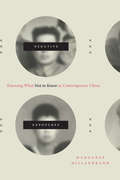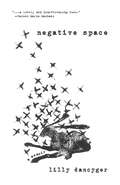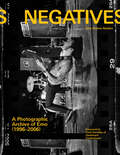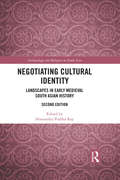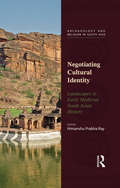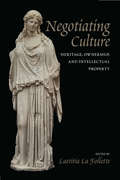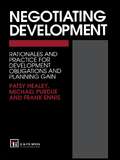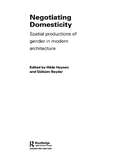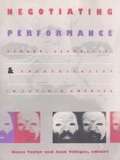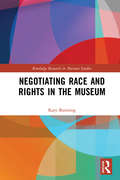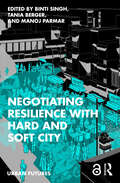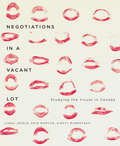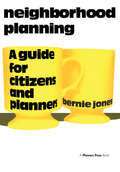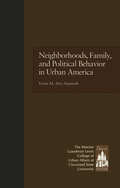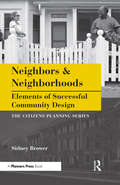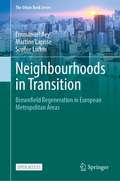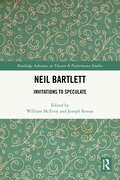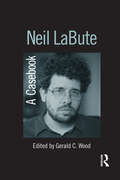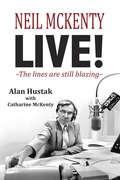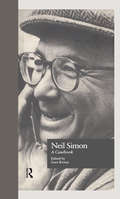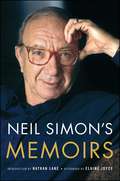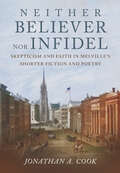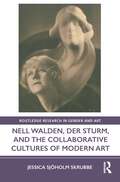- Table View
- List View
Negative Exposures: Knowing What Not to Know in Contemporary China (Sinotheory)
by Margaret HillenbrandWhen nations decide to disown their troubled pasts, how does this strategic disavowal harden into social fact? In Negative Exposures, Margaret Hillenbrand investigates the erasure of key aspects of such momentous events as the Nanjing Massacre, the Cultural Revolution, and the Tiananmen Square protests from the Chinese historical consciousness, not due to amnesia or censorship but through the operations of public secrecy. Knowing what not to know, she argues, has many stakeholders, willing and otherwise, who keep quiet to protect themselves or their families out of shame, pragmatism, or the palliative effects of silence. Hillenbrand shows how secrecy works as a powerful structuring force in Chinese society, one hiding in plain sight, and identifies aesthetic artifacts that serve as modes of reckoning against this phenomenon. She analyses the proliferation of photo-forms—remediations of well-known photographs of troubling historical events rendered in such media as paint, celluloid, fabric, digital imagery, and tattoos—as imaginative spaces in which the shadows of secrecy are provocatively outlined.
Negative Space (SFWP Literary Awards)
by Lilly DancygerDespite her parents' struggles with addiction, Lilly Dancyger always thought of her childhood as a happy one. But what happens when a journalist interrogates her own rosy memories to reveal the instability around the edges? Dancyger's father, Joe Schactman, was part of the iconic 1980s East Village art scene. He created provocative sculptures out of found materials like animal bones, human hair, and broken glass, and brought his young daughter into his gritty, iconoclastic world. She idolized him—despite the escalating heroin addiction that sometimes overshadowed his creative passion. When Schactman died suddenly, just as Dancyger was entering adolescence, she went into her own self-destructive spiral, raging against a world that had taken her father away. As an adult, Dancyger began to question the mythology she'd created about her father—the brilliant artist, struck down in his prime. Using his sculptures, paintings, and prints as a guide, Dancyger sought out the characters from his world who could help her decode the language of her father's work to find the truth of who he really was.
Negatives: A Photographic Archive of Emo (1996-2006)
by Amy Fleisher MaddenA gorgeous hardcover time capsule of the emo music scene as it was from 1996 to 2006, featuring never-before-seen photographs and never-before-told stories from key emo musicians, photographers, and icons.While the term emo has become a familiar label, there was a time when that wasn’t the case. Many bands of the mid-to-late '90s would never have classified themselves as such. With the advent of the 2000s, the previously underground emo scene was put on the map, and the term and sound of the genre morphed into something new. Today, the musical and cultural impact of this movement is alive and well, responsible for some of the biggest and most influential acts of the 21st century, from Jimmy Eat World to My Chemical Romance, and the emo label has been reclaimed by those who can’t imagine life without it. Through rare and never-before-seen photographs Amy Fleisher Madden, founder of Fiddler Records (Dashboard Confessional, New Found Glory, Recover, and more), thoughtfully and lovingly put together this moving archive of the second and third waves of emo. With a foreword by Chris Carrabba of Dashboard Confessional and revealing essays from Frank Iero, Geoff Rickly, Norman Brannon, and Matt Pryor, as well as insights and bite-sized narratives from photographers and other musicians of the era, this heartwarming time capsule expounds an extraordinary moment in music history—a scene that gave life to not only numerous big names but also to a powerful sound and even more powerful friendships. Featuring more than eighty bands, including:Jimmy Eat WorldDashboard ConfessionalMy Chemical RomanceTexas Is the ReasonTaking Back SundayThe Get Up KidsThursdayFall Out BoyAmerican FootballJawbreakerFrom basements and VFW halls to dive bars and holes-in-the-wall, during long overnight drives through the middle of nowhere and stolen moments of sleep in carbon-copy motels, Negatives captures the heart of what made up this tight-knit community, an official archive of life as it was, taking you on stage, behind the curtain, and on the road.A UNIQUE LOVE LETTER FROM EXPERT AUTHOR: The first of its kind, Negatives is not a critic's take—rather a touching and heartfelt time capsule and photographic archive of the scene as told by those who lived it.RARE AND NEVER-BEFORE-SEEN MATERIAL: Founder of Fiddler Records Amy Fleisher Madden compiles hundreds of high-quality photos of more than eighty bands, as well as essays and bite-sized narratives from photographers and key musicians of the era. STAR CONTRIBUTORS: Foreword by Chris Carrabba (Dashboard Confessional) with essays by Frank Iero (My Chemical Romance), Geoff Rickly (Thursday), Norman Brannon (Texas Is the Reason), Matt Pryor (The Get Up Kids), Jesse Johnson (Motion City Soundtrack), Bob Nanna (Braid, Hey Mercedes), and Andrew McMahon (Something Corporate). A MUSIC GIFT FOR EVERY EMO FAN: Focusing on the second and third waves (1996–2006), Negatives includes hundreds of high-quality images of bands including Jimmy Eat World, Dashboard Confessional, My Chemical Romance, Texas Is the Reason, Taking Back Sunday, The Get Up Kids, Thursday, The Promise Ring, American Football, Saosin, and more.Perfect for:Emo fans of all kinds and all wavesFans of second-wave bands like Sunny Day Real Estate, third-wave bands like My Chemical Romance, and indie emo bands like Death Cab for CutieMusic history fansMusicians and aspiring musicians Photography enthusiastsMusic lover's gift idea for birthday, graduation, holiday, or any special occasion
Negotiating Cultural Identity: Landscapes in Early Medieval South Asian History (Archaeology and Religion in South Asia)
by Himanshu Prabha RayThis volume breaks new ground by conceptualizing physical landscapes as living cultural bodies. It redefines dynamic cultural landscapes as catalysts in which the natural world and human practice are inextricably linked and are constantly interacting. Drawing on research by eminent archaeologists, numismatists and historians, the essays in this volume • Provide insights into the ways people in the past, and in the present, imbue places with meanings; • Examine the social and cultural construction of space in the early medieval period in South Asia; • Trace complex patterns of historical development of a temple or a town, to understand ways in which such spaces often become a means of constructing the collective past and social traditions. With a new chapter on continuity and change in the sacred landscape of the Buddhist site at Udayagiri, the second edition of Negotiating Cultural Identity will be of immense interest to scholars and researchers of archaeology, social history, cultural studies, art history and anthropology.
Negotiating Cultural Identity: Landscapes in Early Medieval South Asian History (Archaeology and Religion in South Asia)
by Himanshu Prabha RayThis volume breaks new ground by conceptualizing landscape as a dynamic cultural complex in which the natural world and human practice are inextricably linked and are constantly interacting. It examines the social and cultural construction of space in the early medieval period in South Asia, as manifest in society, religious architecture and as shaped through trade and economic transactions.
Negotiating Culture: Heritage, Ownership, and Intellectual Property
by Laetitia La FolletteRival claims of ownership or control over various aspects of culture are a regular feature of our twenty-first-century world. Such debates are shaping disciplines as diverse as anthropology and archaeology, art history and museum studies, linguistics and genetics. This provocative collection of essays--a series of case studies in cultural ownership by scholars from a range of fields--explores issues of cultural heritage and intellectual property in a variety of contexts, from contests over tangible artifacts as well as more abstract forms of culture such as language and oral traditions to current studies of DNA and genes that combine nature and culture, and even new, nonproprietary models for the sharing of digital technologies. Each chapter sets the debate in its historical and disciplinary context and suggests how the approaches to these issues are changing or should change. One of the most innovative aspects of the volume is the way each author recognizes the social dimensions of group ownership and demonstrates the need for negotiation and new models. The collection as a whole thus challenges the reader to reevaluate traditional ways of thinking about cultural ownership and to examine the broader social contexts within which negotiation over the ownership of culture is taking place. In addition to Laetitia La Follette, contributors include David Bollier, Stephen Clingman, Susan DiGiacomo, Oriol Pi-Sunyer, Margaret Speas, Banu Subramaniam, Joe Watkins, and H. Martin Wobst.
Negotiating Development: Rationales and practice for development obligationsand planning gain
by F. Ennis Frank Ennis P. Healey Prof Patsy Healey M. PurduePlanning gain is the legal process by which property development is linked to social provisions. This book examines the rationale for planning gain and development obligations and reviews the practice of development negotiation through a wide range of case histories.
Negotiating Domesticity: Spatial Productions of Gender in Modern Architecture
by Hilde Heynen Gülsüm BaydarIn the home the intricate relations between architecture, gender and domesticity become visible. Negotiating Domesticity investigates the many and complex themes evoked by the interconnections between these terms. Topics covered include famous as well as less well-known architectural examples and architects, which are explored from sociological, anthropological, philosophical and psychoanalytical approaches. The authors explore the relationships between modern domestic spaces and sexed subjectivities in a broad range of geographical locations of Western modernity. This richly interdisiplinary work presents architects and postgraduate students with an in-depth exploration of domesticity in the modern era.
Negotiating Performance: Gender, Sexuality, and Theatricality in Latin/o America
by Juan Villegas Diana TaylorIn Negotiating Performance, major scholars and practitioners of the theatrical arts consider the diversity of Latin American and U. S. Latino performance: indigenous theater, performance art, living installations, carnival, public demonstrations, and gender acts such as transvestism. By redefining performance to include such events as Mayan and AIDS theater, the Mothers of the Plaza de Mayo, and Argentinean drag culture, this energetic volume discusses the dynamics of Latino/a identity politics and the sometimes discordant intersection of gender, sexuality, and nationalisms.The Latin/o America examined here stretches from Patagonia to New York City, bridging the political and geographical divides between U.S. Latinos and Latin Americans. Moving from Nuyorican casitas in the South Bronx, to subversive street performances in Buenos Aires, to border art from San Diego/Tijuana, this volume negotiates the borders that bring Americans together and keep them apart, while at the same time debating the use of the contested term "Latino/a." In the emerging dialogue, contributors reenvision an inclusive "América," a Latin/o America that does not pit nationality against ethnicity--in other words, a shared space, and a home to all Latin/o Americans.Negotiating Performance opens up the field of Latin/o American theater and performance criticism by looking at performance work by Mayans, women, gays, lesbians, and other marginalized groups. In so doing, this volume will interest a wide audience of students and scholars in feminist and gender studies, theater and performance studies, and Latin American and Latino cultural studies.Contributors. Judith Bettelheim, Sue-Ellen Case, Juan Flores, Jean Franco, Donald H. Frischmann, Guillermo Gómez-Peña, Jorge Huerta, Tiffany Ana López, Jacqueline Lazú, María Teresa Marrero, Cherríe Moraga, Kirsten F. Nigro, Patrick O'Connor, Jorge Salessi, Alberto Sandoval, Cynthia Steele, Diana Taylor, Juan Villegas, Marguerite Waller
Negotiating Race and Rights in the Museum (Routledge Research in Museum Studies)
by Katy BunningNegotiating Race and Rights in the Museum traces the evolution of pervasive racial ideas, and ‘post-race’ allusions, over more than a century of museum thinking and practice. Drawing on the illuminating history of the Smithsonian Institution, this book offers an account of how museums have addressed and renegotiated wider calls for inclusion, ‘self-definition’, and racial justice, in ways that continually re-centre and legitimise the White frame. Charting the emergence of ‘post-race’ ideas in museums, Bunning demonstrates how and why ‘culturally specific’ approaches have been met with suspicion and derision by powerful museum stakeholders against the backdrop of a changing United States of America, just as they have offered crucial vehicles for sectoral change. This study of the evolution of racial ideas in response to Black empowerment highlights deeply entrenched forms of White supremacy that remain operative within the international museum sector today, and serves to reinforce the urgent calls for the active disruption of racist ideas and the redesign of institutions. Negotiating Race and Rights in the Museum will appeal to those working in the international fields of museum and heritage studies, cultural studies, and American studies, and all who are interested in the production of racial ideas and White supremacy in the museum.
Negotiating Resilience with Hard and Soft City (Urban Futures)
by Binti Singh, Tania Berger, and Manoj ParmarThis book explores how cities are shaped by the lived experiences of inhabitants and examines the ways they develop strategies to cope with daily and unexpected challenges. It argues that migration, livelihood, and public health challenges result from inadequacies in the hard city—urban assets, such as land, infrastructure, and housing, and asserts that these challenges and escalating vulnerabilities are best negotiated using the soft city—social capital and community networks. In so doing, the authors criticise a singular knowledge system and argue for a granular, nuanced understanding of cities—of the interrelations between people in places, everyday urbanisms, social relationships, cultural practices, and histories. The volume presents perspectives from the Global South and the Global North and engages with city-specific cases from Africa, India, and Europe for a deeper understanding of resilience. Part of the Urban Futures series, it will be of great interest to students and researchers of urban studies, urban planning, urban management, architecture, urban sociology, urban design, ecology, conservation, and urban sustainability. It will also be useful for urbanists, architects, urban sociologists, city and town planners, policy makers, and those interested in a deeper understanding of the contemporary and future city.
Negotiations in a Vacant Lot
by Lynda Jessup Erin Morton Kirsty RobertsonAt a moment when the discipline of Canadian art history seems to be in flux and the study of Canadian visual culture is gaining traction outside of art history departments, the authors of Negotiations in a Vacant Lot were asked: is "Canada" - or any other nation - still relevant as a category of inquiry? Is our country simply one of many "vacant lots" where class, gender, race, ethnicity, and sexual orientation interact? What happens to the project of Canadian visual history if we imagine that Canada, as essence, place, nation, or ideal, does not exist? The argument that culture is increasingly used as an economic and socio-political resource resonates strongly with the popular strategies of "urban gurus" such as Richard Florida, and increasingly with government policy. Such strategies both contrast with, but also speak to traditions of Canadian state support for culture that have shaped the national(ist) discipline of Canadian art history. The authors of this collection stand at the multiple points where national culture and globalization collide, however, suggesting that academic investigation of the visual in Canada is contested in ways that cannot be contained by arbitrary borders. Bringing together the work of scholars from diverse backgrounds and illustrated with dozens of works of Canadian art, Negotiations in a Vacant Lot unsettles the way we have used "nation" to examine art and culture and looks ahead to a global future. Contributors include Susan Cahill (Nipissing University), Mark A. Cheetham (University of Toronto), Peter Conlin (Academia Sinica, Taipei), Annie Gérin (Université du Québec à Montréal), Richard William Hill (York University), Kristy A. Holmes (Lakehead University), Heather Igloliorte (Concordia University), Barbara Jenkins (Wilfrid Laurier University), Alice Ming Wai Jim (Concordia University), Lynda Jessup (Queen's University), Erin Morton (University of New Brunswick), Kirsty Robertson (Western University), Rob Shields (University of Alberta), Sarah E.K. Smith (Queen's University), Imre Szeman (University of Alberta), and Jennifer VanderBurgh (Saint Mary's University).
Negotiations in a Vacant Lot: Studying the Visual in Canada (McGill-Queen's/Beaverbrook Canadian Foundation Studies in Art History #14)
by Lynda Jessup Erin Morton Kirsty RobertsonAt a moment when the discipline of Canadian art history seems to be in flux and the study of Canadian visual culture is gaining traction outside of art history departments, the authors of Negotiations in a Vacant Lot were asked: is "Canada" - or any other nation - still relevant as a category of inquiry? Is our country simply one of many "vacant lots" where class, gender, race, ethnicity, and sexual orientation interact? What happens to the project of Canadian visual history if we imagine that Canada, as essence, place, nation, or ideal, does not exist? The argument that culture is increasingly used as an economic and socio-political resource resonates strongly with the popular strategies of "urban gurus" such as Richard Florida, and increasingly with government policy. Such strategies both contrast with, but also speak to traditions of Canadian state support for culture that have shaped the national(ist) discipline of Canadian art history. The authors of this collection stand at the multiple points where national culture and globalization collide, however, suggesting that academic investigation of the visual in Canada is contested in ways that cannot be contained by arbitrary borders. Bringing together the work of scholars from diverse backgrounds and illustrated with dozens of works of Canadian art, Negotiations in a Vacant Lot unsettles the way we have used "nation" to examine art and culture and looks ahead to a global future. Contributors include Susan Cahill (Nipissing University), Mark A. Cheetham (University of Toronto), Peter Conlin (Academia Sinica, Taipei), Annie Gérin (Université du Québec à Montréal), Richard William Hill (York University), Kristy A. Holmes (Lakehead University), Heather Igloliorte (Concordia University), Barbara Jenkins (Wilfrid Laurier University), Alice Ming Wai Jim (Concordia University), Lynda Jessup (Queen’s University), Erin Morton (University of New Brunswick), Kirsty Robertson (Western University), Rob Shields (University of Alberta), Sarah E.K. Smith (Queen’s University), Imre Szeman (University of Alberta), and Jennifer VanderBurgh (Saint Mary’s University).
Neighborhood Planning: A Guide for Citizens and Planners
by Bernie JonesFirst published in 1990. Routledge is an imprint of Taylor & Francis, an informa company. This guide explains neighborhood planning for both citizens and professionals. It explains what information to collect, where to get it, and how to assess it; how to pinpoint key issues, set clear goals, and devise strategies to achieve them; and how to package, implement, and update the final plan. Although this book could be used by citizens working alone, Jones advocates a team approach—citizens and professionals planning together. He highlights which tasks are best suited to the professional and how the planner should manage his role as intermediary between the city administration and residents. Jones also takes a detailed look at the neighborhood plan itself. Numerous maps illustrate how to inventory environmental features, land uses, circulation systems, and design features.
Neighborhoods, Family, and Political Behavior in Urban America: Political Behavior & Orientations (Contemporary Urban Affairs)
by Yvette Alex-AssensohUndergirded by a multidisciplinary framework of political science, geography, and sociology, this book examines hte manner in which neighborhood economic resources and family structure shape individual political behavior among white and black citizens in urban America.
Neighbors and Neighborhoods: Elements of Successful Community Design
by Sidney BrowerHow does the design of a neighborhood affect the people who live there? In this thoughtful, engaging book, the author explains how a neighborhood’s design lays the groundwork for the social relationships that make it a community. Blending social science with personal interviews, the author shares the lessons of planned communities from historic Riverside, Illinois, to archetypal Levittown, New York, and Disney’s Celebration, Florida. Through these inspirational stories, readers will discover the characteristics of neighborhoods that promote the attitudes and behaviors of a healthy community. This volume is an eye-opener for everyone who’s wondered what makes their local neighborhoods tick. It demystifies the way planners, architects, developers, organizers, and citizens come together in crafting a community’s physical elements, policies, programs, and processes. Readers will come away with a new understanding of their roles in creating the communities they want.
Neighbourhoods in Transition: Brownfield Regeneration in European Metropolitan Areas (The Urban Book Series)
by Emmanuel Rey Martine Laprise Sophie LufkinThis open access book is focused on the intersection between urban brownfields and the sustainability transitions of metreopolitan areas, cities and neighbourhoods. It provides both a theoretical and practical approach to the topic, offering a thorough introduction to urban brownfields and regeneration projects as well as an operational monitoring tool. Neighbourhoods in Transition begins with an overview of historic urban development and strategic areas in the hearts of towns to be developed. It then defines several key issues related to the topic, including urban brownfields, regeneration projects, and sustainability issues related to neighbourhood development. The second part of this book is focused on support tools, explaining the challenges faced, the steps involved in a regeneration process, and offering an operational monitoring tool. It applies the unique tool to case studies in three selected neighbourhoods and the outcomes of one case study are also presented and discussed, highlighting its benefits.The audience for this book will be both professional and academic. It will support researchers as an up-to-date reference book on urban brownfield regeneration projects, and also the work of architects, urban designers, urban planners and engineers involved in sustainability transitions of the built environment.
Neil Bartlett: Invitations to Speculate (Routledge Advances in Theatre & Performance Studies)
by William McEvoy Joseph RonanThis book explores Neil Bartlett’s groundbreaking contributions to queer cultural production in the United Kingdom. It adopts a range of critical perspectives, presenting original scholarship on Bartlett’s fiction, theatre, performance, site-specific work, and adaptations, as well as more personal reflections on Bartlett’s influence and legacy.Charting his emergence as a radical queer artist in the 1970s, his writing for performance and theatre in the 1980s to the present day, and his evocative novels about queer spaces and hidden histories, the book considers Bartlett’s works as ‘invitations to speculate’: to view and imagine otherwise, as part of a political aesthetics committed to making queer lives visible. Bartlett’s bold, sensuous, and challenging work crosses genres to find new ways of articulating queer desires, unearthing histories of the body, pleasure, and gay subjectivity while connecting queer experiences across time.Dealing with topics including memory and loss, AIDS and its legacy, marginality, community, and identity, the collection shows how Bartlett embraces the past as a way of reimagining queer futures and demonstrates his status as one of the UK’s leading queer artists.
Neil LaBute: A Casebook (Casebooks on Modern Dramatists)
by Gerald C. WoodNeil LaBute: A Casebook is the first book to examine one of the most successful and controversial contemporary American playwrights and filmmakers. While he is most famous, and in some cases infamous, for his early films In the Company of Men and Your Friends and Neighbors, Labute is equally accomplished as a playwright. His work extends from the critique of false religiosity in Bash to examinations of opportunism, irresponsible art, failed parenting, and racism in later plays like Mercy Seat, The Shape of Things, The Distance From Here, Fat Pig, Autobahn, and the very recent This Is How It Goes and Some Girls. Like David Mamet, an acknowledged influence on him, and Conor McPhereson, with whom he shares some stylistic and thematic concerns, LaBute tends to polarize audiences. The angry voices, violent situations, and irresponsible behavior in his works, especially those focusing on male characters, have alienated some viewers. But the writer's religious affiliation and refusal to condone the actions of his characters suggest he is neither exploitive nor pornographic. This casebook explores the primary issues of the writer's style, themes, and dramatic achievements. Contributors describe, for example, the influences (both classical and contemporary) on his work, his distinctive vision in theater and film, the role of religious belief in his work, and his satire. In addition to the critical introduction by Wood and the original essays by leading dramatic and literary scholars, the volume also includes a bibliography and a chronology of the playwright's life and works.
Neil McKenty Live: The lines are still blazing
by Catharine Mckenty Alan HustakNeil McKenty liked to argue just for the hell of it. During the 1970's and 80s he was one of Montreal's highest rated radio talk show hosts. At the peak of his career more than 75,000 people tuned in to CJAD to hear his show, Exchange. 'The basic exchange on Exchange, is not between the listeners and Neil McKenty," he once explained. "It is between the listeners. If the host sets up the chemistry, the show goes on its own momentum, and I am almost on the sidelines. On the other hand, I am in the entertainment business. If I bore my listeners, I'm dead." The material collected in this book focuses on the years he moderated, infuriated, provoked and entertained his listeners.
Neil Simon: A Casebook (Casebooks on Modern Dramatists #No. 21)
by Gary KonasFirst Published in 1997.The 16 essays and interviews in this volume explore the background and works of Neil Simon, the most successful playwright in American history. Several of the entries trace Simon's Jewish heritage and its influence on his plays. Although Simon is best known as a writer of a remarkable series of hit Broadway comedies, the contributors to this book have identified a number of "serious" recurring themes in his work, suggesting that a reassessment of the playwright as a dramatist is appropriate. Three interviews with Simon and his longtime producer yield valuable facts about the playwright that will, along with the critical essays, aid the scholar seeking new insights into contemporary American drama in general and Neil Simon in particular.
Neil Simon's Memoirs
by Neil SimonThe complete memoirs of playwright Neil Simon--the author of such iconic works as Lost in Yonkers, The Odd Couple, Biloxi Blues, and The Goodbye Girl--now with a new introduction and afterword.This omnibus edition combines Neil Simon's two memoirs, Rewrites and The Play Goes On, into one volume that spans his extraordinary five-decade career in theater, television, and film. Rewrites takes Simon through his first love, his first play, and his first brush with failure. There is the humor of growing up in Washington Heights (the inspiration for his play Brighton Beach Memoirs) where, despite his parents' rocky marriage and many separations, he learned to see the funny side of family drama, as when his mother screamed thinking she saw a body on the floor in their apartment--it turned out to be the clothes his father discarded in the hallway after a night of carousing. He describes his marriage to his beloved wife Joan, and writes lucidly about the pain of losing her to cancer. The Play Goes On adds to his life's story, as he wins the Pulitzer Prize and reflects with humor and insight on his tumultuous life and meteoric career. Now, with the whole story in one place, Neil Simon's collected memoirs trace the history of modern entertainment over the last fifty years through the eyes of a man who started life the son of a garment salesman and became the greatest--and most successful--American playwright of all time.
Neither Believer nor Infidel: Skepticism and Faith in Melville's Shorter Fiction and Poetry
by Jonathan A. CookShedding new light on both classic and lesser-known works in the Melville canon with particular attention to the author's literary use of the Bible, Neither Believer Nor Infidel examines the debate between religious skepticism and Christian faith that infused Herman Melville's writings following Moby-Dick. Jonathan A. Cook's study is the first to focus on the decisive role of faith and doubt in Melville's writings following his mid-career turn to shorter fiction, and still later to poetry, as a result of the commercial failures of Moby-Dick and Pierre. Nathaniel Hawthorne claimed that Melville "can neither believe nor be comfortable in his unbelief," a remark that encapsulates an essential truth about Melville's attitude to Christianity. Like many of his Victorian contemporaries, Melville spent his literary career poised between an intellectual rejection of Christian dogma and an emotional attachment to the consolations of non-dogmatic Christian faith. Accompanying this ambivalence was a lifelong devotion to the text of the King James Bible as both moral sourcebook and literary template. Following a biographical overview of skeptical influences and manifestations in Melville's early life and career, Cook examines the evidence of religious doubt and belief in "Bartleby, the Scrivener," "Cock-a-Doodle-Doo!," "The Encantadas," Israel Potter, Battle-Pieces, Timoleon, and Billy Budd. Accessible for both the general reader and the scholar, Neither Believer Nor Infidel clarifies the ambiguities of Melville's pervasive use of religion in his fiction and poetry. In analyzing Melville's persistent oscillation between metaphysical rebellion and attenuated belief, Cook elucidates both well-known and under-appreciated works.
Nell Walden, Der Sturm, and the Collaborative Cultures of Modern Art (Routledge Research in Gender and Art)
by Jessica Sjöholm SkrubbeBased on hitherto overlooked archival material, this book reveals Nell Walden’s significant impact on the Sturm organisation through a feminist reading of supportive labour that highlights the centrality of collaborative work within the modern art world. This book introduces Walden as an ardent collector of modern and indigenous art and critically contextualises her own art production in relation to expressionist concepts of art and to gendered ideas on abstraction and decoration. Visual analyses highlight how she collaborated with professional and experimental women photographers during the Weimar era and how the circulation of these photographs served as a means to intervene in the public sphere of culture in interwar Germany. Finally, the book provides an analysis of Walden’s continuing work for Der Sturm after her voluntary exile from Germany to Switzerland in 1933 and highlights the importance of women’s supportive labour for the canonisation and institutionalisation of modern art in museums and archives. The book will be of interest to scholars working in art history, visual studies, and gender studies.
Nelly: Eine Schildkröte auf Reisen
by Abril Barrao Sarina GebelDieses Kinderbuch wurde von der zehnjährigen Abril Barrao, Tochter des Schriftstellers Isaac Barrao, verfasst. "Nelly: Eine Schildkröte auf Reisen" ist ein Buch für Kinder zwischen 2 und 6 Jahren. Gemeinsam mit einem Erwachsenen können die kleinen Leser in eine magische Welt voller Spaß eintauchen. Das Kinderbuch stellt eine unterhaltsame Pflichtlektüre für die ganz Kleinen dar, die mit diesem Buch etwas über soziale, materielle und ethische Werte lernen. Diese sind wichtig, um Liebe, Freundschaft und Respekt gegenüber anderen zu entwickeln. Abril Barrao Miró, Tochter des Schriftstellers Isaac Barrao, lädt uns alle auf spielerische Weise in eine Erzählung ein, die von ebenjenen alltäglichen und notwendigen Werten geprägt ist. Wer, wenn nicht ein zehnjähriges Mädchen, könnte diese fantastische Welt besser verstehen, die wir, die Erwachsenen, längst vergessen haben?
